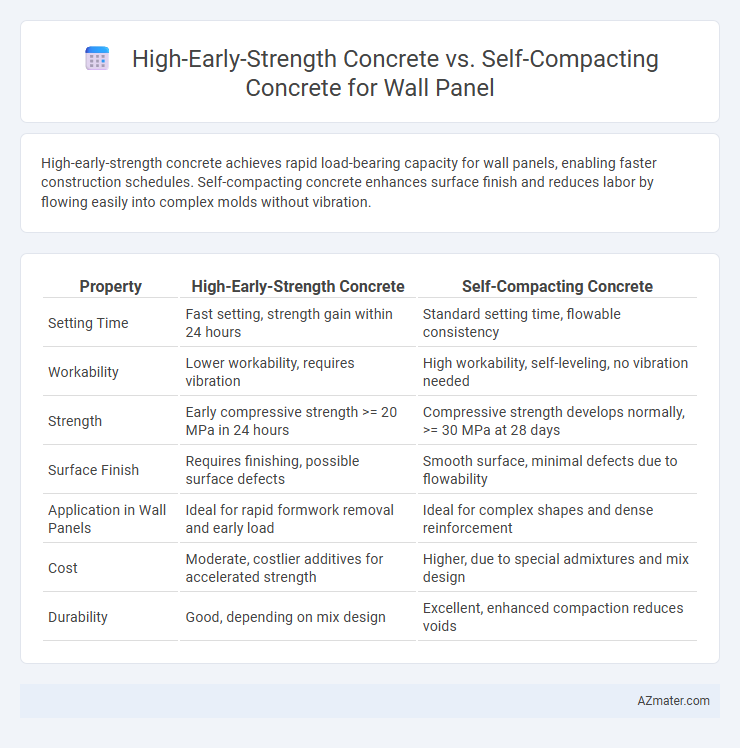High-early-strength concrete achieves rapid load-bearing capacity for wall panels, enabling faster construction schedules. Self-compacting concrete enhances surface finish and reduces labor by flowing easily into complex molds without vibration.
Table of Comparison
| Property | High-Early-Strength Concrete | Self-Compacting Concrete |
|---|---|---|
| Setting Time | Fast setting, strength gain within 24 hours | Standard setting time, flowable consistency |
| Workability | Lower workability, requires vibration | High workability, self-leveling, no vibration needed |
| Strength | Early compressive strength >= 20 MPa in 24 hours | Compressive strength develops normally, >= 30 MPa at 28 days |
| Surface Finish | Requires finishing, possible surface defects | Smooth surface, minimal defects due to flowability |
| Application in Wall Panels | Ideal for rapid formwork removal and early load | Ideal for complex shapes and dense reinforcement |
| Cost | Moderate, costlier additives for accelerated strength | Higher, due to special admixtures and mix design |
| Durability | Good, depending on mix design | Excellent, enhanced compaction reduces voids |
Introduction to Wall Panel Concrete Solutions
High-early-strength concrete offers rapid strength gain, enabling quicker formwork removal and faster construction schedules for wall panels, crucial in time-sensitive projects. Self-compacting concrete enhances workability and ensures uniform filling of intricate wall panel molds without mechanical vibration, improving surface finish and reducing labor costs. Both solutions optimize wall panel production by balancing strength development and placement efficiency to meet diverse architectural and structural demands.
Defining High-Early-Strength Concrete (HESC)
High-Early-Strength Concrete (HESC) is engineered to achieve compressive strengths typically exceeding 20 MPa within the first 24 hours, enabling rapid construction and early formwork removal in wall panel applications. Its accelerated hydration is often achieved through the use of high cement content, specific admixtures, and optimized curing conditions, distinguishing it from traditional mixtures and Self-Compacting Concrete (SCC). Compared to SCC, which emphasizes flowability and void-free placement without vibration, HESC prioritizes early mechanical performance critical to fast-track structural assembly.
Understanding Self-Compacting Concrete (SCC)
Self-Compacting Concrete (SCC) is designed for high flowability, enabling it to fill complex wall panel molds without mechanical vibration, reducing labor and ensuring uniform surface finish. Its composition includes a higher proportion of fine materials and viscosity-modifying agents, optimizing workability and stability while maintaining strength and durability. SCC's ability to achieve consistent compaction and dense microstructure makes it ideal for thin, intricate wall panels where traditional high-early-strength concrete may struggle with placement and finish quality.
Key Material Properties: HESC vs SCC
High-early-strength concrete (HESC) offers rapid strength development, achieving compressive strengths above 20 MPa within 24 hours, making it ideal for fast-track construction of wall panels requiring early load-bearing capacity. Self-compacting concrete (SCC) provides excellent flowability and filling ability without segregation, ensuring uniform consolidation around dense reinforcement in wall panels, which enhances surface finish and reduces honeycombing defects. HESC emphasizes high early compressive strength and durability, while SCC prioritizes superior workability, homogeneity, and resistance to void formation, crucial for complex wall panel geometries.
Workability and Placement Differences
High-early-strength concrete offers rapid strength development ideal for fast construction schedules, but its lower workability requires mechanical vibration for proper compaction in wall panels. Self-compacting concrete excels in flowability and can fill complex formwork without segregation or external vibration, ensuring uniform placement and surface finish. The superior placement ease of self-compacting concrete reduces labor costs and minimizes defects, while high-early-strength concrete demands careful handling to prevent voids and honeycombing.
Curing Time and Construction Speed Comparison
High-early-strength concrete achieves significant strength within 24 hours, enabling faster curing times and earlier formwork removal in wall panel construction, which accelerates overall project timelines. Self-compacting concrete, while offering superior flowability and reduced labor for placement, typically requires standard curing periods of 7 to 28 days, potentially slowing construction speed despite improved workability. For projects prioritizing rapid turnaround, high-early-strength concrete is preferable due to its expedited curing and early load-bearing capacity.
Surface Finish and Aesthetic Considerations
High-early-strength concrete offers a denser surface with minimal bleeding, resulting in a smoother and more uniform finish ideal for visually critical wall panels. Self-compacting concrete provides superior flowability that fills complex formworks without vibration, reducing surface imperfections but may require careful mix design to prevent excessive surface porosity. Both types influence aesthetic outcomes, with high-early-strength concrete favoring early demolding and sharp details while self-compacting concrete enhances intricate shapes and texture consistency.
Structural Performance in Wall Panels
High-early-strength concrete offers rapid strength gain, enabling faster construction schedules and early formwork removal, which enhances the structural integrity of wall panels under load. Self-compacting concrete improves structural performance through superior flowability and consolidation, eliminating voids and ensuring uniform concrete density, which increases durability and load-bearing capacity in wall panels. Comparative studies indicate that self-compacting concrete provides better crack resistance and surface finish, while high-early-strength concrete excels in scenarios requiring quick structural capacity development.
Cost Implications and Material Efficiency
High-early-strength concrete accelerates construction timelines, reducing labor and formwork costs for wall panels but typically requires higher cement content, increasing material expenses. Self-compacting concrete enhances material efficiency by minimizing vibration labor and ensuring uniform compaction, leading to fewer defects and lower repair costs, though material costs may rise due to admixtures. Choosing between the two depends on project priorities: rapid strength gain with higher cement costs versus improved placement efficiency and surface finish at a premium admixture cost.
Choosing the Right Concrete for Wall Panels
High-early-strength concrete offers rapid strength gain, reducing formwork time and enabling faster construction cycles ideal for projects with tight schedules. Self-compacting concrete enhances flowability and eliminates the need for vibration, ensuring uniform filling of complex wall panel molds and superior surface finish quality. Selecting the right concrete depends on prioritizing early load-bearing capacity versus ease of placement and aesthetic requirements for precast or cast-in-place wall panels.

Infographic: High-early-strength concrete vs Self-compacting concrete for Wall panel
 azmater.com
azmater.com